
December 31, 2009
Biodiversity in Design Education
None of my design students could identify the nest of a squirrel. I found this surprising. For something so common (and conspicuous) in our environment, these tree dreys seem to go unnoticed. Why is this? Do students lack a sense of curiosity for their natural environment? Has their digital world eclipsed physical experience? And more ominously, does being oblivious lead to oblivion?
“The sixth great extinction spasm of geological time is upon us, grace of mankind,” warns scientist E. O. Wilson. [1] Biodiversity is being threatened. He forecasts that “a fifth or more of the species of plants and animals could vanish or be doomed to early extinction by the year 2020 unless better efforts are made to save them.” [2] Better efforts start with education, right? Professors know that curiosity can be cultivated and awareness leads to action. During this period of species decline, we’re conversely witnessing a population explosion in design education — a pinnacle moment in the field. By strategically educating this populace — these future leaders in communication design — could the spasm be quelled? I am encouraged by its potential. As evidenced by a recent course I taught, [3] the assimilation of science into design curricula offers immediate cognitive, cultural, and environmental gain.
The course Design for the Understanding of Natural History focused on image-making strategies that responded to scientific observations. Students researched a specimen (mammal, bird, reptile, fish, or insect) from their local ecosystem (Meadowbrook Prairie Park, in Urbana, Illinois) and identified one distinctive behavior to diagram (i.e. shrew caravanning). Ultimately, the project result was to educate patrons as they experienced the park. Lessons in biodiversity not only played a substantial role in course content but also in course development. Variation was the goal. Classroom environments, activities, and strategies changed often, and unfolded like this:
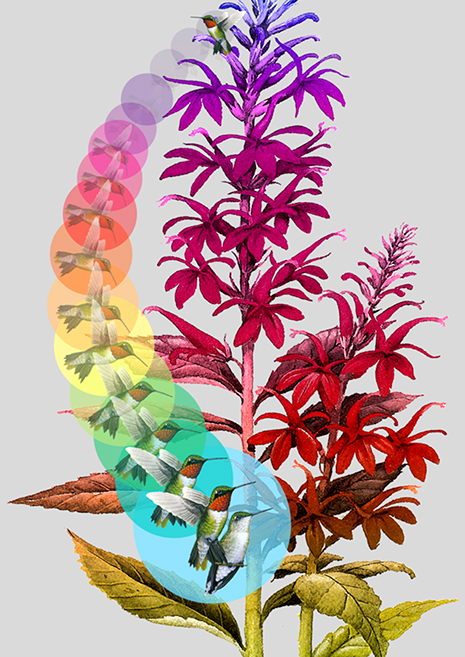
The landing pattern of the ruby-throated hummingbird | Jasmine Vargas, sophomore
Variation in environment
This class balanced indoor with outdoor activity to enhance healthy assignment experiences. As Emerson said of Thoreau: “The length of his walk uniformly made the length of his writing. If shut up in the house, he did not write at all.” Could it be true that the more you move, the better you think? Yes, in fact there is research that suggests our brains perform better when moving, as opposed to sitting. [4] Our students had the concrete experience of hiking in a park, guided by scientists, making first-hand observations. They saw evidence of beavers from teethmarks in wood; they heard the jarring call of a ring-necked pheasant; they identified animal runways in tall prairie grass; and they committed the formal characteristics of poison ivy to memory (sometimes rote learning is smart pedagogy!). Projects were grounded in scientific method with real-world, transferable, design lessons. These types of authentic experience aid in learning.
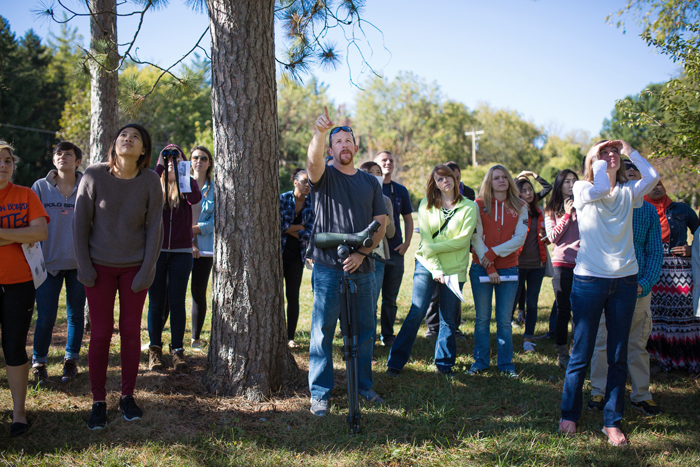
Our class bird watching with Dr. Michael Ward, an avian ecologist | photograph by Daryl Quitalig
Variation in content
As opposed to being assigned one research area, each student selected his or her own, which increased motivation. (They had ownership over their education.) “I didn’t think that an earthworm would be so interesting … I ended up reading and learning about more than just the behavior.” Suddenly, students became topical specialists. What is the metamorphosis of a cicada? Have you seen the waggle dance of a bee? What animals are “crepuscular”? (Oh deer, how do you even pronounce that?) Research findings were publicly presented, educating the class collectively. A traditionally taught course (i.e. lecture-based) could not offer the amount of empirical knowledge that was exhumed — a fortunate outcome.
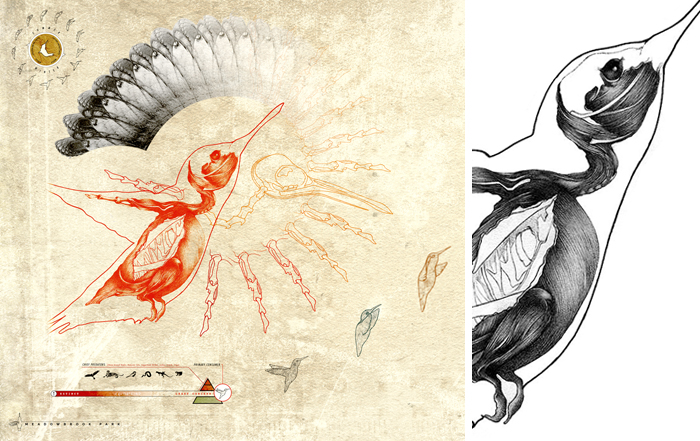 Flight pattern of the ruby-throated hummingbird. Poster detail, left; preparatory drawing, right | Emmett Boblick, senior
Flight pattern of the ruby-throated hummingbird. Poster detail, left; preparatory drawing, right | Emmett Boblick, senior
Variation in process
Imaging studies strategically required a didactic to decorative range. Explorations emphasized variation over refinement; quantity over quality; possibility over probability. Quick solutions provoked harder questions: How do you represent a scientific behavior understandably? Designing for instructional materials was in itself instructive. Visual language strategies were tested and evaluated: Do arrows have intrinsic meaning? Is spatial placement (up, down) associated with value (good, bad)? Could dashed lines (or tinted shapes) represent causality? Are sequenced images always indicative of time? Decorative designs, on the other hand, focused on pure aesthetics and the affordances of the medium.

Foraging and striking behavior of the common garter snake. Visual communication improves by adding numbers, arrows and a background to the original sketch. Notice how the bottom snake breaks the frame (right), creating a sense of depth and motion | Madeline Maranto, sophomore
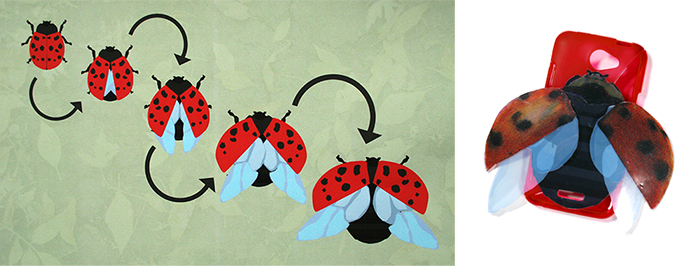
How the ladybug’s elytra prepares for flight, diagram, left; 3D project extension (iPhone case), right | Jillian Martin, sophomore
 Dogbane leaf beetle didactic trailmarker: “Beetles open their elytra and extend their wings in order to take off.” This rotating disk, etched in transparent green plexiglas, attaches to outdoor surfaces where the beetle is likely to be found and reveals how they fly | Bryan Lorenz, junior
Dogbane leaf beetle didactic trailmarker: “Beetles open their elytra and extend their wings in order to take off.” This rotating disk, etched in transparent green plexiglas, attaches to outdoor surfaces where the beetle is likely to be found and reveals how they fly | Bryan Lorenz, junior
Imposing this range had instructional motive: (1) The process allowed for serendipity. (2) Students had to think in a variety of ways which expanded cognitive response. (3) It considered a broader pool of learners (i.e. some students were stronger formally while others excelled at cognitive challenges). (4) Bracketing guaranteed results. If “contrast is a powerful pedagogy,” [5] it was only after looking at the range of visual solutions that an assessment could be made. Only then could students identify compositions that were purely formal vs. ones with instructional potential. In the end, natural selection was at play.
 Decorative luna moth designs, patterning study, left; didactic packaging, right | Rebecca Lu, junior
Decorative luna moth designs, patterning study, left; didactic packaging, right | Rebecca Lu, junior
Variation in task
Daily activities were tactical and diverse, aimed to “alter the entire pattern and procedures of the classroom and create an altogether new educational form.” [6] Diverse critique methods were employed — one-on-one, breakout, and all-class sessions — to disseminate information and component skills. A recent study of chimps in Uganda shows evidence of social learning whereby the alpha chimp discovers a new tool for drinking (the *new and improved* moss sponge over the leaf sponge). This unique tool, through observation and emulation, is shared knowledge, and the technique gradually spreads throughout the culture. How do you design a course to discover and disseminate the moss sponge? The answer is through strategic, shared experiences. Students — ranging from sophomores to seniors — actively shared research, technical skills, problem-solution strategies, and ingenuity, through a prescribed group agenda. As opposed to traditional learning (lecture-based) these types of organized “discussions elicit higher levels of reflective thinking and creative problem solving.” [7]
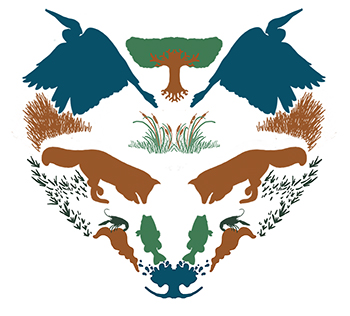
Ecosystem visualization. “Team Fox” (represented by this mark) was a group of students working together; individually, they researched the heron, fox, crayfish, bass, and ladybug | Chang-Wook Park, sophomore
It seems the success of the class, as defined here, stemmed from variation and collaboration. Lectures given by a mammalogist, an avian ecologist, and an animal sciences specialist had enormous impact on the students. [8] Sometimes when the right partnerships are made, and pedagogy performs, transcendental moments in learning occur. Understanding science through design methodology (and vice versa) may have lasting results, but at the very least it created a greater awareness for nature. Poetically, E.O. Wilson attributes biodiversity’s diminishing rate “grace of mankind.” Perhaps through integrating science into design’s core curricula, well before 2020, the sixth great extinction spasm of geological time could be delayed, “grace of design.”
The image collection continues, showcasing a range of innovative solutions:

Row 1: Raccoon vision | Dane Georges, junior. Row 2: The annual plumage cycle of a male American goldfinch | Jordan Donellan, junior; the nuthatch’s climbing ability | Heather Stickney, senior. Row 3: the waggle dance of a bee. Row 4: the foraging (pouncing) behavior of the red fox | Kelley Jacobsen, junior; left and Stacie Sansone, junior; right. Row 5: the distinctive walk of the great blue heron | Scott Durand, junior; the fishing ability of a heron | Brendan Blaber, sophomore
NOTES
[1] Edward O. Wilson, The Diversity of Life (Cambridge, MA: Harvard University Press, 1992).
[2] Ibid.
[3] “Design for the Understanding of Natural History” was a five-week module taught at the University of Illinois, in the fall of 2013. Each module was comprised of approximately thirty students and invited a different scientist into the class.
[4] Terry Doyle, Learner-centered Teaching: Putting the Research on Learning into Practice (Sterling, VA: Stylus, 2011).
[5] Edward A. Hamilton, Graphic Design for the Computer Age: Visual Communication for all Media (New York: Van Nostrand Reinhold, 1970).
[6] Marshall McLuhan, Take Thirty, Canadian Broadcasting Corporation, 1965
[7] Doyle 2011
[8] Our class greatly profited from the scientific knowledge of university professors: Dr. Joseph Merritt, a mammalogist from the Prairie Research Institute; Dr. Michael Ward, an avian ecologist from the Department of Natural Resources and Environmental Sciences; and Dr. Walter L. Hurley, an animal sciences specialist, from the Agricultural Education Program — all walking textbooks.
Observed
View all
Observed
By Kathleen Meaney
Related Posts

Business
Kim Devall|Essays
The most disruptive thing a brand can do is be human

Design of Business | Business of Design
Lee Moreau|Audio
The Past, Present and Future of Design with Lee Moreau, DB|BD Season 12 Finale
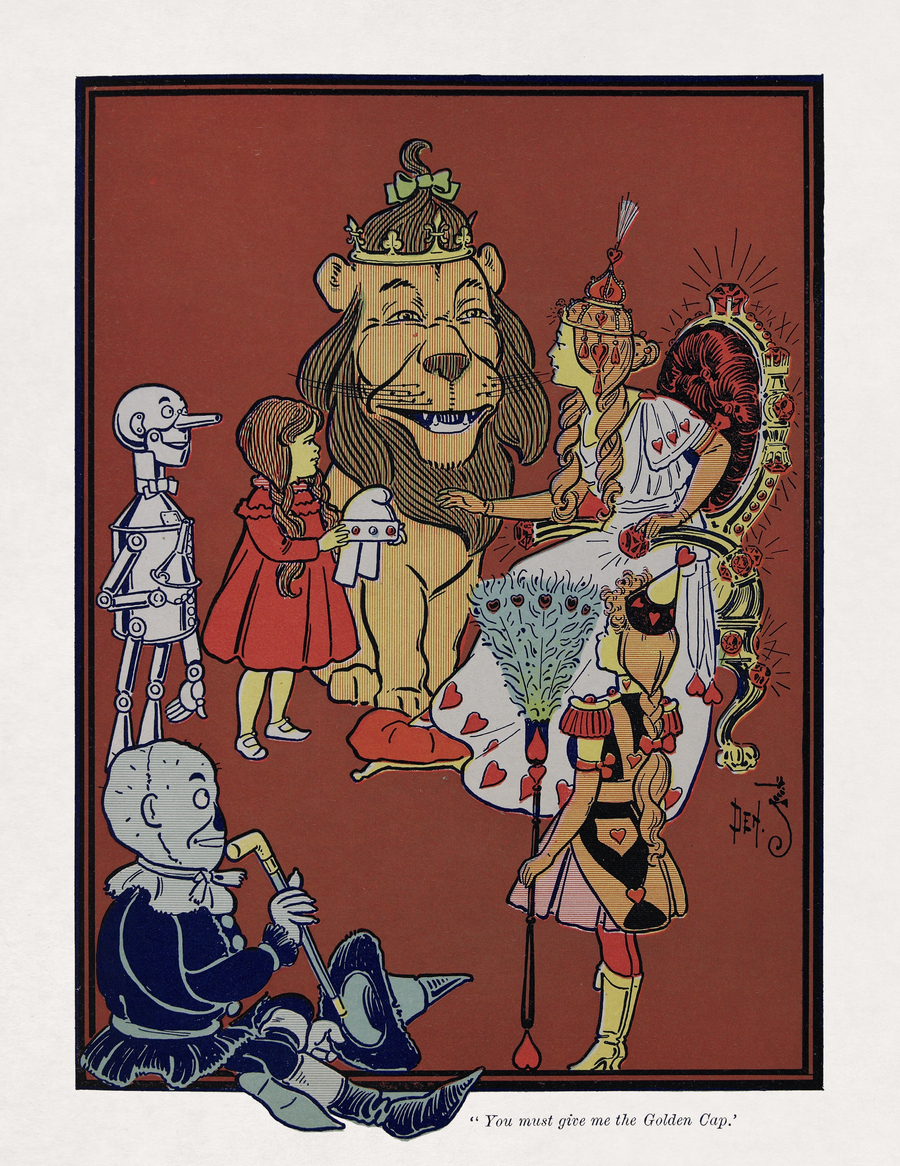
AI Observer
Lee Moreau|Critique
The Wizards of AI are sad and lonely men

Business
Louisa Eunice|Essays
The afterlife of souvenirs: what survives between culture and commerce?
Related Posts

Business
Kim Devall|Essays
The most disruptive thing a brand can do is be human

Design of Business | Business of Design
Lee Moreau|Audio
The Past, Present and Future of Design with Lee Moreau, DB|BD Season 12 Finale

AI Observer
Lee Moreau|Critique
The Wizards of AI are sad and lonely men

Business
Louisa Eunice|Essays

 Kathleen Meaney is a designer, educator and recent fellow at the Smithsonian Institution. Her current research focuses on translating exhibit design for digital learning. She began her career at Pentagram in New York and since then has been a dedicated professor at the School of Visual Arts, North Carolina State University, and the University of Cincinnati. Find Katie in HOW Books’ Women of Design, Chronicle Books’ Design School Wisdom and @university_of_type on Instagram.
Kathleen Meaney is a designer, educator and recent fellow at the Smithsonian Institution. Her current research focuses on translating exhibit design for digital learning. She began her career at Pentagram in New York and since then has been a dedicated professor at the School of Visual Arts, North Carolina State University, and the University of Cincinnati. Find Katie in HOW Books’ Women of Design, Chronicle Books’ Design School Wisdom and @university_of_type on Instagram.